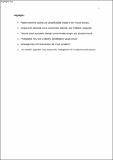Pattern-sensitive patients with epilepsy use uncomfortable visual stimuli to self-induce seizures
Abstract
Sensory stimuli can induce seizures in patients with epilepsy and predisposed subjects. Visual stimuli are the most common triggers, provoking seizures through an abnormal response to light or pattern. Sensitive patients may intentionally provoke their seizures through visual stimuli. Self-induction methods are widely described in photo-sensitive patients, while there are only a few reports of those who are pattern-sensitive. We analyzed 73 images of environmental visual triggers collected from 14 pattern-sensitive patients with self-induced seizures. The images were categorized according to their topics: 29 Objects (43%); 19 Patterns (28%); 15 External scenes (22%); 4 TV or computer screens (6%). Six photos were of poor quality and were excluded from analysis. Images were analyzed by an algorithm that calculated the degree to which the Fourier amplitude spectrum differed from that in images from nature. The algorithm has been shown to predict discomfort in healthy observers. The algorithm identified thirty-one images (46%) as “uncomfortable”. There were significant differences between groups of images (ANOVA p = .0036; Chi2 p < .0279), with higher values of difference from nature in the images classified as “Objects” (mean 6,81E+11; SD 6,72E+11; n.17, 59%) and “Pattern” (mean 9,05E+11; SD 6,86E+11; n.14, 74%). During the semi-structured face-to-face interviews, all patients described the visual triggers as ‘uncomfortable’; the appearance of enjoyable visual epileptic symptoms (especially multi-colored hallucinations) transformed uncomfortable images into pleasant stimuli. Patients considered self-induction as the simplest and most effective way to overcome stressful situations, suggesting that self-inducing pattern-sensitive patients often use uncomfortable visual stimuli to trigger their seizures. Among the reasons for the self-inducing behavior, the accidental discovery of pleasurable epileptic symptoms related to these “uncomfortable” visual stimuli should be considered.
Citation
Brinciotti , M , Wilkins , A J , Penacchio , O & Matricardi , M 2021 , ' Pattern-sensitive patients with epilepsy use uncomfortable visual stimuli to self-induce seizures ' , Epilepsy & Behaviour , vol. 122 , 108189 . https://doi.org/10.1016/j.yebeh.2021.108189
Publication
Epilepsy & Behaviour
Status
Peer reviewed
ISSN
1525-5050Type
Journal article
Collections
Items in the St Andrews Research Repository are protected by copyright, with all rights reserved, unless otherwise indicated.

